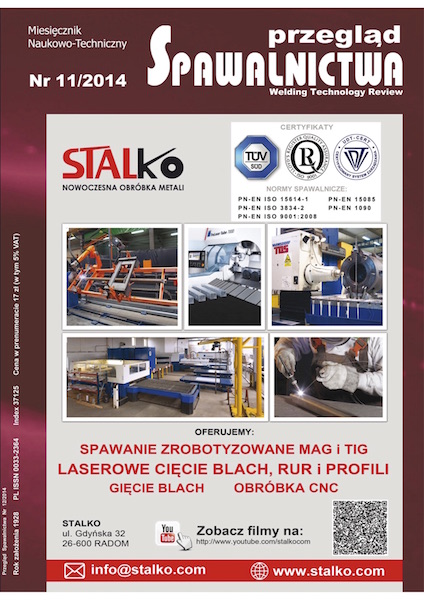Analiza możliwości oceny procesu pełzania stali X12CrMoWVNbN10-1-1 na podstawie szumu Barkhausena
Main Article Content
Abstract
Streszczenie
Przeprowadzono pomiary polowego efektu Barkhausena oraz pętli histerezy na cylindrycznych próbkach stali X12CrMowVnbn10-1-1 średnicy 4 i długości 15 mm. Analizowano zmiany wielkości ilościowo opisujących badane efekty pomiędzy próbkami w stanie dostawy i po pełzaniu. Szukano takich wielkości magnetycznych, dla których wpływ zmian własności mechanicznych i mikrostruktury, zachodzących wskutek procesu pełzania, jest najbardziej widoczny. Dla polowego efektu Barkhausena procesy pełzania stali X12CrMowVnbn10-1-1 powodują wzrost maksymalnej amplitudy składowych widma FFT oraz wzrost energii szumu Barkhausena. Analizując pętlę histerezy, stwierdzono spadki pola koercji po procesie pełzania. Analiza falkowa pokazała, że sygnały dla próbek w stanie dostawy cechują się większą regularnością, niż sygnały dla próbek po pełzaniu. Proces pełzania po- woduje pojawienie się impulsów o niższych częstotliwościach, które nie występują dla próbek w stanie dostawy. Stwierdzone zmiany parametrów magnetycznych są podstawą do prowadzenia dalszych badań wpływu procesów pełzania na ich zmiany. Końcowym celem tych badań jest określenie korelacji pomiędzy zmianami wartości parametrów magnetycznych a stopniem zaawansowania procesu pełzania.
Abstract
The Barkhausen effect and the hysteresis loop were measured on 15 mm long cylindrical X12CrMowVnbn10-1-1 steel specimens with a diameter of 4 mm. An analysis was conducted of the changes that describe the effects under analysis quantitatively. new specimens (in the as-delivered state) and post-creep specimens (destroyed due to creep) were compared. The aim was to find magnetic quantities for which the impact of creep-related changes in the mechanical properties and microstructure is the most visible. For the Barkhausen effect, the steel X12CrMowVnbn10-1-1 creep processes result in a rise in the maximum value of the amplitude of the components of the FFT spectrum and the Barkhausen noise energy. Analyzing the hysteresis loop, drops in coercivity were found after the creep proc- ess was completed. The results of the wavelet analysis showed that the as-delivered state specimens signals are more regular than for post-creep specimens. Creep process causes the appearance of the low-frequency pulses which are not present in the as-delivered state specimens. The results of the testing are the basis for further research on the impact of creep processes on changes in magnetic properties. The ultimate object of the research is to determine the correlations between changes in values of magnetic parameters and the progress of creep.
Downloads
Article Details
Creative Commons CC BY 4.0 https://creativecommons.org/licenses/by/4.0/
Welding Technology Review (WTR) articles are published open access under a CC BY licence (Creative Commons Attribution 4.0 International licence). The CC BY licence is the most open licence available and considered the industry 'gold standard' for open access; it is also preferred by many funders. This licence allows readers to copy and redistribute the material in any medium or format, and to alter, transform, or build upon the material, including for commercial use, providing the original author is credited.
References
J. N. Mohapatra, A. K. Ray, J. Swaminathan, A. Mitra: Creep behaviour study of virgin and service exposed 5Cr0.5Mo steel using magnetic Barkhausen emissions technique, Journal of Magnetism and Magnetic Materials, Vol. 320, Iss. 18, Sep- tember 2008, s. 2284-2290.
M. J. Sablik, B. Augustyniak, L. Piotrowski: Modeling incipient creep damage effects on Barkhausen noise and magnetoacoustic emission, Journal of Magnetism and Magnetic Materials, Volumes 272276, Supplement, May 2004, s. E523E525, Proceedings of the International Conference on Magnetism (ICM 2003).
Dong-Won Kim, Dongil Kwon: Quantification of the Bar- khausen noise method for the evaluation of time-dependent degradation, Journal of Magnetism and Magnetic Materials, Vol. 257, Iss. 2-3, February 2003, s. 175-183.
Huiran Cui, Feng Sun, Ke Chen, Lanting Zhang, Rongchun wan, Aidang Shan, Jiansheng wu: Precipitation behavior of Laves phase in 10%Cr steel X12CrMowVnbn10-1-1 during short-term creep exposure, Materials Science and Engi- neering A 527 (2010) 7505-7509.
G. Götz, w. Blum: Influence of thermal history on precipitation of hardening phases in tempered martensite steel of type X12CrMowVnbn10-1-1, Mater. Sci. Eng. A, 348/1-2:201 207, 2003.
